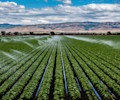Today (22 March) marks the UN World Water Day, an occasion to celebrate water and raise awareness of the global water-quality crisis that we currently face.
The risk is especially acute for the animal agriculture sector, which accounts for the use of 30% of all freshwater resources. UN World Water Day is a timely reminder that investors failing to account for water risks in their food investment portfolios could be misallocating capital by overpaying for assets expected to underperform financially due to increased material impacts from higher feed costs, operational disruptions in the supply chain and tougher environmental regulations.
Water has a material and environmental value. In this blog, we outline how investors can protect it.
Animal protein producers are failing on water stewardship and proper management
Chicken | Pig | Beef | Pulses |
|---|---|---|---|
4235 L/Kg | 5988 L/Kg | 15415 L/Kg | 4055 L/Kg |
The livestock sector is responsible for much of the water shortages across the US, and the projected increase in the consumption of animal proteins by 12% in the next decade is likely to put further pressure on this vital natural resource.
Several countries are also experiencing major pollution problems caused by animal agriculture throughout the chain of production. Improper handling of manure, poor wastewater management by processing facilities and sediment runoff exert significant pressure on the environment by polluting local reservoirs and having lasting impacts on water quality. In the US, pollution from animal feeding operations threatens or impairs more than 14,000 miles of rivers and streams and 90,000 acres of lakes and ponds. North Carolina is a notorious example of the impacts of water pollution caused by pork production. The state has an estimated population of 9.7 million pigs that produce 10 billion pounds of manure annually, which is mostly flushed into open pits called lagoons. In the last decade, North Carolina has been more regularly hit by hurricanes and extreme weather events, such as Matthew in 2016 and Florence in 2018, causing the waste lagoons to overflow their banks and spread bacteria, antibiotics, heavy metals and nitrogen into the state’s rivers and groundwater supply.
Water stewardship and proper management are critically important to ensure the sustainability of the animal agriculture sector. So far, evidence shows that animal protein producers are far from making progress to manage water-related risks.
Water is a material risk for animal protein producers
Animal protein producers have a critical dependency on freshwater resources to conduct their business operations, from feed farming to animal farming and processing. Poor water management poses a serious material risk, and failure to mitigate water risks often translates to rising costs and supply chain disruption. The short-term physical impacts from water scarcity are reduced productivity from interruption of operations at processing plants, higher feed costs from lower yields, and increased vulnerability to wildfires. In the long term, soil erosion and higher livestock mortality are likely to impact protein producer companies. The proper functioning of food supply chains relies on freshwater, and all of these effects will have a material impact for investors.
In fact, companies assessed by the Coller FAIRR Protein Producer Index are already being financially impacted by these risks. Inghams Group Ltd, an Australian-based meat producer, discloses being challenged by higher operational costs related to water scarcity, namely higher feed costs and increasing competition for scarce water in processing plants. To combat the reliance on town‑supplied water, which can become stressed due to lower supply in drought conditions, Inghams Group is investing in an on‑site bore water treatment plant in its Te Aroha processing plant in New Zealand to reuse water, an example of sound water risk mitigation.
Companies are also exposed to the material risks of stricter environmental regulations and litigations related to water pollution. Following several fines for violations of environmental protection laws due to manure spills and water pollution in North Carolina, Smithfield Foods announced a $500 million joint venture to produce biogas by capturing the methane from lagoons and transporting it through pipelines to a processing plant. However, NGOs and rural communities are questioning this system as a solution to the hog waste pollution problems.
How investors can act on water risks
In 2016, a group of institutional investors representing $1 trillion in assets urged some of the world’s largest meat producers (namely, JBS, Perdue Farms and Smithfield Foods) to take greater action on water scarcity and pollution. Tyson Foods has also received several shareholder resolutions by investors asking the company to implement a policy to reduce risks of water pollution. Investors highlight the companies face risks to operate, as well as reputational, and financial risks as consumer attention to the environmental impacts of meat production increase.
Investors can use their influence to urge company action on water risk. Using findings from the FAIRR Coller Index, we have identified three key actions investors can urge companies to take:
Conduct water risk assessments. Companies should conduct water risk assessments across the supply chain, including feed farming, animal farming and processing facilities. In the risk assessment, the company should identify locations with high water stress from a scarcity and quality perspective and publicly disclose the results.
Set time-bound targets. Animal protein producers should set time-bound targets to reduce overall water consumption and improve the quality of wastewater discharged by processing facilities. Companies should disclose metrics related to water quality and details such as whether the targets are absolute, or intensity-based, as well as a baseline and a target year, to achieve them. For instance, the World Bank’s recommendation for wastewater limit parameters are: 30 BOD mg/L (Biochemical Oxygen Demand), 125 COD mg/L (Chemical Oxygen Demand), 2 TP mg/L (Total Phosphorus), and 10 TN mg/L (Total Nitrogen).
Engage with suppliers/growers on managing water use and pollution. Companies should offer their suppliers in animal farming and crop production comprehensive guidance, support and/or incentives to improve practices in water use and nutrient management/fertilizer use. Examples of support include providing subsidies to encourage the adoption of approaches and technologies for reducing water use in feed farming, and providing incentives to farmers to adopt technologies to turn animal manure into biogas.
UN World Water Day is not only a day to celebrate water, but also a call to action for us to protect it. As a major water consumer and polluter, investors with assets in animal agriculture companies can play a significant role in protecting and preserving the value of water.
FAIRR insights are written by FAIRR team members and occasionally co-authored with guest contributors. The authors write in their individual capacity and do not necessarily represent the FAIRR view.












